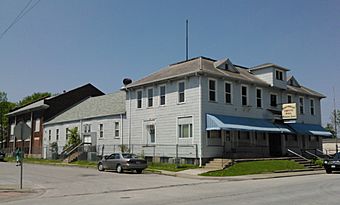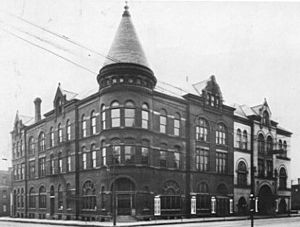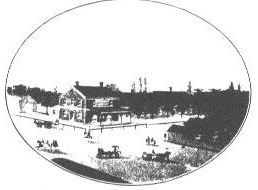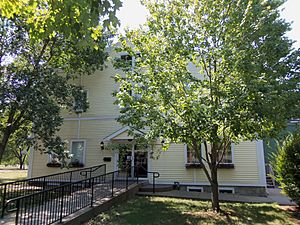Northwest Davenport Turner Society Hall facts for kids
Quick facts for kids |
|
|
Northwest Davenport
Turner Society Hall |
|
 |
|
| Location | 1602 Washington St. Davenport, Iowa |
|---|---|
| Area | 1 acre (0.40 ha) |
| Built | 1882, 1904, 1926 |
| Architect | Frederick G. Clausen Rudolph J. Clausen |
| NRHP reference No. | 79000941 |
| Added to NRHP | July 10, 1979 |
The Northwest Davenport Turner Society Hall is a special old building in Davenport, Iowa. It's important because it shows the history of the German community in Davenport. Germans were the biggest and most important group of immigrants in the city. This hall was a key place for their community and culture in northwest Davenport. It has been listed on the National Register of Historic Places since 1979, which means it's a historic landmark worth protecting.
Contents
History of the Turners
Who Were the Turners?
The Turner movement started in Germany with a teacher named Friedrich Ludwig Jahn (1778–1852). In 1811, he began teaching outdoor physical education classes in Berlin. His main goals were to help people get fit and to build a strong sense of German pride.
Over the next 30 years, many gymnastic clubs called Turnvereins opened across Germany. The members of these clubs were known as “Turners,” which is the German word for gymnasts. These clubs were also places where people could gather and talk about wanting more freedom and fairness in their governments.
When a big revolution happened in Germany in 1848, it didn't succeed. Many Turners had supported this revolution, so they had to leave Germany. A lot of them came to the United States, and many settled in Davenport, Iowa.
Turners Arrive in Davenport
Two important Turners who came to Davenport were Theodor Gülich and Christian Müller. They helped start the first Turner society in the city in 1852. Theodor Gülich's family had been involved in movements for change back in Germany.
In 1854, at the Turners' first big public event, Gülich said that their local society would fight against unfair treatment of immigrants and against too much control by the church. He also said they would work to promote freedom, education, and well-being for everyone.
The early Turners in Davenport were very forward-thinking. They supported social issues like women's rights. They also helped create the German Free School Society in Davenport, which offered education to children.
At first, the local Turner society was called the Sozialistischer Turnverein (Socialistic Turner Society). Even though they sometimes criticized American society, they wanted to be good Americans. They expected new members to become American citizens before joining. They also took part in Fourth of July celebrations. However, in 1876, during the country's 100th birthday celebration, they left the parade when a prayer was added, showing their strong beliefs against church control.
Over time, their more radical ideas became less strong, and they gave up hope of returning to Germany to continue the revolution. In 1858, the group changed its name to the Davenporter Turnverein. Then, in 1882, it changed again to the Davenporter Turngemeinde. As more Germans moved to the city in the 1870s, the number of Turner societies in Davenport grew from one to three.
The Northwest Turners Hall
The Northwest Davenport Turner Society started in 1871. Their first meeting place was Jacobsen's Hall, which was a boarding house and a tavern. Sadly, this building was destroyed in a fire on July 4, 1882.
Soon after the fire, a new building was built at 16th and Washington Streets. This new Turner Hall continued to be a place for members to exercise their bodies and minds. They also held fun folk festivals in a garden next to the hall. The society grew as more German immigrants came to Davenport.
In 1904, the Turners made their hall bigger. They hired Frederick G. Clausen, a well-known architect from Davenport who was also from Germany. The hall was updated again in 1926 by Clausen's son, Rudolph, who continued his father's architecture business.
Both the East and Northwest Turner societies continued to be active in Davenport until at least the 1980s. The Northwest Davenport Turner Society sold their building in 1991. It then became a club called Uncle Roscoe's Polo Club. In 1994, a Masonic group called the Mohassan Grotto bought the building. They used it to host bingo games to raise money.
In 2017, Compassion Church bought the building. They now use it for their breakfast program, called Timothy's House of Hope. The Northwest Turners organization is still active today, but they no longer have their own hall. Members now meet at different places around the city and even sponsor bowling and golf teams.
Other Turner Halls in Scott County
At one time, there were five Turner halls in Scott County. Two of these were in Davenport. The Central Turner Hall, built in 1888, was located downtown. It was the second largest Turner Hall in the United States! Sadly, it was damaged in a fire in 1961 and torn down in 1975 to make way for new housing.
The East Turner Hall, built in 1891, is still standing in the Village of East Davenport and is now used as a theater. There was also a Turner hall in Buffalo (built 1869) that burned down in 1961, and one in Eldridge (around 1885) that was destroyed by fire in 2013.
Building Design
The original part of the 1882 building was almost square. It had two floors and a hipped roof (a roof that slopes on all four sides). The main entrance was on the front, with a small triangular decoration above it. A gymnasium was attached to the back of this main building. It was a wooden structure with a gable roof (a roof with two sloping sides that meet at a ridge).
In 1904, more sections were added to the building. The main entrance was moved, and new windows were put in. The original gymnasium was changed into a movie theater and dance hall. A brand new gymnasium, made of brick on a stone base, was built next to the old one. This new gym also had a gable roof.
The 1926 changes updated the front of the building. The windows on the first floor were made larger, and big plate glass windows were installed. The front part of the building, facing Washington Street, was turned into two storefronts. The second floor became an apartment. The main entrance now led into a hallway between the storefronts, which went to the auditorium and dance hall.






